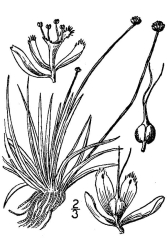Eriocaulon Parkeri
 |
 |
Photo Renee Brecht |
Britton & Brown |
| Botanical name: | Eriocaulon Parkeri |
| Common name: | Parker's pipewort |
| Group: | monocot |
| Family: | Eriocaulaceae |
| Growth type: | forb/herb |
| Duration: | Perennial; however, research by The New England Wild Flower Society (1994) indicates that the species behaves as an annual rather than a perennial. |
| Origin: | native |
| Plant height: | 1.0-20 cm |
| Foliage: | Rosette with a spongy base, with delicate, grass-like leaves, 2-5 mm wide, tapering leaves 2-6 cm long |
| Flower: | Two to four leafless scapes with 4-5 ridges (angular in cross-section), 2.5-10 cm long, bear a button-like cluster of minutely hair or hairless terminal flower heads that are 3-6 mm in diameter. Flowers are unisexual, with 2 sepals and 2 white petals. Nectar producing gland just below the tip of the petal. |
| Flowering time: | flowers late July, into September; fruit, capsules with two elliptical .5 mm-long seeds. |
| Habitat: | Freshwater intertidal zones in estuaries, generally submerged by daily tides and seen at lower tides. |
| Range in New Jersey: | Coastal strip of Coastal plain and the Delaware Bay shore |
| Heritage ranking, if any: | S2, HL |
| Distribution: |  |
| Misc. | Compound of Greek erion, wool, and caulos, a stalk, from the woool at the base of the scape in the original species (Fernald, 390).
Compound of Greek erion, wool, and caulos, a stalk, from the woool at the base of the scape in the original species (Fernald, 390). According to Witmer Stone, it was first recognized by Dr. Robinson as distinct from a specimen collected Discovered by Charles F. Parker, 1820-1883. In NJ, it is associated with��Elatine americana, E. minima, Isoetes riparia, Limosella subulata, Micranthemum micranthemoides, Sagittaria subulata,��and��Zizania aquatica. (Ferren and Schuyler, 1980, as quoted in ESA available below) Pollination is undetermined; some experts suggest that they are autogamous (self-pollinated) or entomophilous (insect-pollinated), while Gleason and Cronquist (1991) suggest they are either anemophilous (wind-pollinated) or entomophilous. Ruhland (1930) and Schuyler (1990) suggest that the tiny mites that crawl around the flower heads are not highly mobile, pollination likely occurs between flowers on the same head. Schulyer also suggests seeds are wind or water dispersed, and Haines (2001) suggests seeds may also be dispersed by waterfowl. NJ Element Stewardship Abstract available here. This plant is also profiled on the Center for Plant Conservation website. |